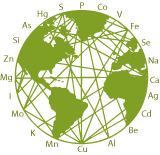Water Analysis
Accreditation: DIN EN ISO/IEC 17025
Water is tested for total recoverable metals in accordance with EPA Methods and the European Drinking Water Regulation. Water test values are compared to the Maximum Contaminant Levels (MCL) as defined by EPA and the European Water Regulation Offices. Since regulations are less stringent in the USA compared to Europe, we compare test values to European norms, but list EPA norms as well.
Routine Basic Water Profile (Hardness Included) (P8)
Needed Material: 5-7ml water
Aluminium, Antimony, Arsenic-total, Barium, Beryllium, Boron, Cadmium, Calcium, Chromium, Copper, Iron, Lead, Magnesium, Manganese, Mercury, Nickel, Selenium, Silver, Strontium, Thallium, Uranium, Zinc
Short Water Profile (Hardness Included) (P80)
Needed Material: 5-7ml water
Cadmium, Calcium, Copper, Lead, Magnesium, Nickel, Uranium, Zinc
Uranium Water Profile (Uranium)
Needed Material: 5-7ml water
Lithium in water associated with Autism
New research studies have found that consuming lithium-contaminated tap water during pregnancy could be associated with an increased risk of newborn autism development. As lithium levels increased, so did the risk of an autism diagnosis.
Water analysis as offered by Micro Trace Minerals seems warranted during and after pregnancy. We routinely test lithium in water.
https://neurosciencenews.com/lithium-water-autism-22922/
Some countries have high lithium reserves . To find out more about your country's lithium production, check this site.
https://worldpopulationreview.com/country-rankings/lithium-reserves-by-country
Download
Download Water Submission Form, fill out and send with water sample. Regular mail or air mail is acceptable. Metals are not affected by shipping time.
Uranium in drinking water. How does it get there?
Uranium occurs naturally in soil and rocks. It can enter groundwater and contaminate drinking water, which, over time, can harm health. In certain regions such as Nebraska, uranium is more present in rocks, soil and water than in other areas. Uranium cannot be detected by taste, sight or smell.
In drinking water, the chemical properties of uranium are of greater concern than its radioactivity. Studies show that elevated levels of uranium in drinking water can affect the kidneys. In Nova Scotia, uranium levels in drinking water are between 0.005 and 0.83 milligrams per litre (mg/L). The Canadian guideline for uranium in drinking water is 0.02 mg/L.
Uranium concentrations of up to 700 µg/litre (=0.7mg/l) have been found in private supplies in Canada (Moss et al., 1983; Moss, 1985). A study in Finland examined a population receiving drinking-water containing uranium with a median concentration of 28 µg/litre (Kurttio et al., 2002). In a study of 476 Norwegian groundwater samples, 18% had uranium concentrations in excess of 20 µg/litre (=0.02mg/l)(Frengstad et al., 2000). Concentrations in excess of 20 µg/litre have been reported in groundwater from parts of New Mexico, USA (Hakonson-Hayes et al., 2002), and central Australia (Hostetler et al., 1998; Fitzgerald et al., 1999).
Uranium in Mineral Water
There is no statutory binding maximum level for uranium in mineral water. When manufacturers claim that these waters are suitable for the preparation of infant formula, the mineral water in question may not contain more than 2 microgram uranium per litre.
The German environmental agency guideline for tap and mineral water is10 microgramm per litre.
The World Health Organisation (WHO) gives a guideline value of 15 microgram per litre.
Metal-Contamination of Drinking Water
The EPA has set maximum contaminant levels (MCL) for metals including arsenic, barium, cadmium, chromium, lead, copper, mercury, selenium, nickel, thallium, antimony, and beryllium. This means that public water supplies are monitored for these metals regularly. Private systems are not monitored. It is up to the owner or consumer to test and treat their water..
Lead and copper can leach from water pipes and soldered joints which deliver water to our tap. This is especially a problem in older homes. The toxic effects of lead can lead to nerve and brain damage. Children are especially sensitive. Exposure may also lead to kidney damage, and blood disorders .
Copper, a by-product of pipe corrosion, acid mine drainage, iron and steel production, and sewage treatment can cause anemia, digestive disturbances and liver and kidney damage at high exposure levels.
Chromium, a by-product of mining, chrome plating, cement production, detergents, and incineration can cause liver and kidney damage.
Household water filters generally contain silver, and may be the source of a higher silver contratration in drinking water.
Cardiovascular risk and water
The Influence of calcium and magnesium in drinking water and diet on cardiovascular risk factor in individuals living in hard and soft water areas with differences in cardiovascular mortality http://www.biomedcentral.com/1471-2458/3/21/
Bottled water better than tap?
The Natural Resources Defense Council (NRDC) performed testing on bottled water and contracted with an independent data verification firm to confirm the accuracy of its test results. They found: Nearly one in four of the waters tested (23 of the 103 water samples tested) violated strict applicable state (California) limits for bottled water in at least one sample, most commonly for arsenic or certain cancer-causing man-made ("synthetic") organic compounds.
